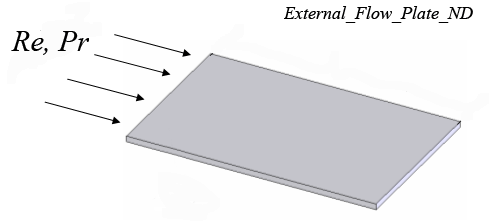
External_Flow_Plate_ND

Procedure External_Flow_Plate_ND(Re,Pr: Nusselt,C_f) returns the average Nusselt number and friction coefficient for parallel to a flat plate.
Inputs:
Re - Reynold's number [-], where
![]()
where
r is the density of the fluid
m is the viscosity of the fluid
L is the length of the plate
u_infinity is the velocity of the flow
Pr - Prandtl number [-], where
![]()
where
c_p is the specific heat capacity of the fluid
k is the conductivity
Outputs:
Nusselt - average Nusselt number assuming a constant wall temperature[-]. The Nusselt number is defined:
![]()
where
h is the average heat transfer coefficient
C_f - average friction coefficient [-]. The friction coefficient is defined:
![]()
where
t is the average shear stress
Notes
This procedure is called by External_Flow_Plate to calculate the Nusselt number and coefficient of drag. When the flow is laminar(Re<5e5), the Nusselt number is determined by the Churchill and Ozoe (1973) correlation as presented in section 4.9.2 of Nellis and Klein. This correlation is valid for all Prandtl numbers provided that the Peclet number is larger than about 100. When the flow is mixed (Re>5e5), the friction coefficient is calculated using a correlation from White that is applicable for Re up to 1e10. The Nusselt number is calculated using the correlation described by Jili and in Section 8.3 of Nellis and Klein. Mixed conditions are assumed in the turbulent region. It is valid for Reynolds numbers above the assumed turbulent transition Reynolds number of 5e5 and below about 1e8. The correlation is best applied to fluids with Prandtl numbers from 0.6<Pr<60.
The Reynolds and Prandtl numbers are based on fluid properties evaluated at the film temperature, which is the average of the free stream and the surface temperatures.
Example
call External_Flow_Plate_ND(Re,Pr: Nusselt,C_f)
Re=10000 [-]
Pr=0.8 [-]
{Solution: Nusselt=60.72 [-], C_d=0.01328}